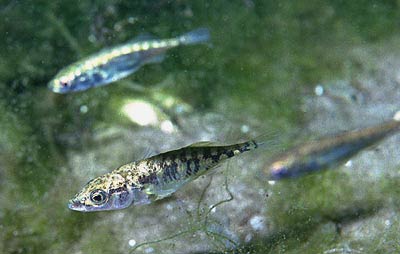We're open daily! View holiday hours
Science News
Stunning Stickleback Sequences
April 11, 2012

Threespine sticklebacks are evolutionary wonders. About 10,000 years ago, when glaciers melted, many of these teeny saltwater fish found themselves swimming in freshwater lakes and streams. So, as nature is wont to do, the sticklebacks adapted.
Now, saltwater sticklebacks are larger and plated with scaly armor and spikes. The freshwater fish are smaller, faster, and sport less armor. These adaptations happened over an eye-blink in evolutionary time, making the fish ideal subjects of genetic studies.
“We studied sticklebacks because you can see the timing of the adaptation very clearly, over 10,000 years instead of millions of years,” says Kerstin Lindblad-Toh of the Broad Institute. “You see signatures that tell you very specifically where in the genome the adaptive pressure has been acting.”
Lindblad-Toh and her colleagues, led by Stanford’s David Kingsley, published a stunning stickleback sequencing study last week in Nature.
Sticklebacks are found throughout the world, but the researchers started with a freshwater female from Alaska, sequencing its entire genome. The researchers then sequenced the genomes of 10 pairs of marine and freshwater fish from North America, Europe and Japan.
From Nature News:
The researchers found that, over most of the genomes, freshwater sticklebacks were most similar to their nearest ocean-dwelling neighbors. But in about 150 DNA sequences, freshwater and saltwater populations were each more like their counterparts in the same environments across the globe.
The researchers found 147 “reused” regions in the fish’s genome. That suggests that each time the fish left the sea, variants in this same group of genes helped remodel the fish into forms that were better suited to fresh water, Kingsley says.
So what are these genes? The reused regions include key armor genes that Kingsley and colleagues previously identified, and many others involved in metabolism, developmental signaling and behavioral interactions between animals. The study highlights some genes in which alterations likely aid fish adapting to life in a less salty environment.
“Some sections of chromosomes are chock full of differences that are contributing to evolution,” says Kingsley. “It is quite dramatic to look at the entire genome and see these powerful chunks being used over and over again."
The stickleback sequences also allowed the researchers to tackle one of the most contentious issues in evolutionary biology. Researchers have battled over what type of genetic changes spur evolution. Some scientists argue for changes to the coding sections of the genome, the portions that cells read to make proteins. More influential, other researchers contend, are alterations to regulatory DNA, which controls the activity of genes.
“Here, it isn’t either-or,” says Kingsley. The team’s analysis suggests that both kinds of changes occurred during stickleback evolution, but regulatory changes were about four times as common. “We finally get an idea of the relative contributions of both mechanisms, to a whole range of traits that have evolved in the wild.”
Image: Ron Offermans/Wikipedia